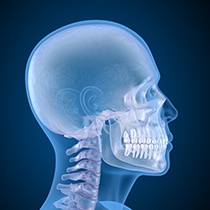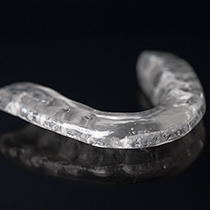TMJ Treatment – Astoria, NY
Improve Your Jaw Function & Comfort

Temporomandibular joint dysfunction (TMD) occurs when the joints connecting the jawbone to the skull are strained or damaged. This may occur for a number of reasons including excessive use and facial trauma. Whatever the cause, TMD can be extremely painful or significantly limit the movement of a patient’s jaw. Dr. Shkurti has years of training and experience to offer accurate diagnosis and effective treatment for patients suffering from TMD. At ED Family Dental, we welcome patients from the Bronx and other Burroughs to contact our dental office in Astoria to schedule an appointment.
Why Choose ED Family Dental for TMJ Treatment?
- Clean, Modern & Comfortable Dental Office
- Late & Weekend Appointments Available
- We Welcome Emergencies & Walk-Ins
What is TMJ Disorder?

TMJ disorder is a condition that impacts the function, comfort, and easy movement of the two jaw joints (temporomandibular joints) that connect either side of your lower jaw to your upper jaw. When these joints are functioning properly, you should be able to effortlessly open and close your mouth and chew food. However, if the muscles around the joints, as well as the joints themselves, are strained, it can lead to a number of uncomfortable symptoms that disrupt your daily life and routine. In these cases, we recommend calling our office to schedule an examination.
Symptoms of TMJ Disorder

TMD has numerous causes, and the symptoms can be just as varied. We encourage patients to contact our team right away if they experience any of the following warning signs of TMJ dysfunction in Astoria:
- Jaw pain
- Inability to fully open or close the mouth
- Clicking or grinding sound when opening and closing the mouth
- Chronic headache, earache, neck pain, or backache
Types of TMJ Treatment

These side effects of TMD may seem innocuous at first, but left untreated, this dysfunction may cause even the simplest activities like chewing or speaking to be painful or impossible. We offer a number of treatment options to help relieve TMJ pain and restore full, comfortable jaw function including joint stretching exercises and wearing an oral appliance while sleeping. If patients do not achieve the desired result, we may recommend occlusal adjustment or a customized occlusal splint.
Occlusal Splint

If you experience bruxism (teeth grinding), clicking and popping of the jaw joints when you open and close your mouth, and other uncomfortable symptoms, a customized occlusal splint may be the best treatment option for you. Our team will take impressions of your mouth that we’ll send off to our dental laboratory to craft a durable oral appliance that you will wear before going to sleep. It’s designed to gently shift your jaw into its ideal position to relieve stress and strain from your jaw joints. With regular use over time, you’ll notice that your TMJ symptoms become less persistent and uncomfortable.
Equilibration/Occlusal Adjustment

In more advanced cases of TMD, patients may need to adjust the position of their jaw. By achieving a more ideal alignment, the jaw may undergo less unconscious shifting to seek a comfortable position, and experience decreased strain during use. In most cases, we’ll attempt minimally invasive treatment options prior to occlusal adjustment, but when necessary, we offer a variety of solutions. Depending on the severity of the occlusal misalignment, we may recommend orthodontic care, an occlusal splint, or surgical treatments.
TMJ Treatment FAQs
How do I know my TMJs are causing my discomfort?
TMJ issues can easily go unnoticed, even during common doctor’s appointments like routine physicals. Dr. Shkurti has studied the way the jaw moves and debilitating conditions that can affect it for many years now, so seeing him is a great place to start. Since TMD can cause a large variety of symptoms, it helps to have a professional confirm them individually. This will also make it easier to determine the best treatment option for you.
What is TMJ treatment like?
Dr. Shkurti will first perform a detailed exam of your mouth and jaw, then capture a series of X-rays to examine your jaw joints more closely. During this portion of your visit, he can confirm if undue stress is being applied to them. From there, he’ll create a treatment plan that specifically addresses your needs. Not only can he ease your current symptoms, including chronic headaches and jaw pain, but he can prevent long-term issues like upper back pain from arising as well.
How long does TMJ treatment take?
There are a few different factors that can influence the length of your treatment time. For one, if you have a severe case of TMD, that will require more time and examination to resolve. If your jaw pain is caused by a physical injury rather than long-term bite problems, that can also influence your treatment length.
Once you arrive and receive an exam, we can explain how long your treatment may take depending on your specific case. In some instances, you may start noticing improvements in your symptoms in as little as one week of using an occlusal splint. With that said, we will never rush your treatment or let you leave feeling unsatisfied.
Will I have to worry about relapses with TMJ treatment?
When your jaw is injured or there is muscle tension, discomfort can come back in the future. Additionally, if you no longer wear the oral appliance prescribed to you, either because it’s lost or damaged, your muscles can continue to tense up. This inevitably causes discomfort in your head, neck and even upper back. To reduce these instances, also known as TMD-flareups, always make sure to visit our practice for follow-up appointments and follow all instructions provided by Dr. Shkurti.
Does TMJ treatment hurt?
TMJ treatment is designed to relieve pain, not cause it! At our practice, we offer conservative and comfortable solutions such as occlusal splints and occlusal adjustments. An occlusal splint is very similar to a mouthguard, and it will help reduce the strain placed on your jaw joints and muscles. Better yet, they’re custom-designed to fit comfortably and should not be painful to wear at all. Occlusal adjustments involve gently reshaping small areas of your teeth to create a more balanced bite. While this may sound intense, rest assured, this process is very precise and typically causes little to no discomfort at all. Most patients find that these treatments are not only painless but are actually very effective in reducing overall jaw pain, tension, and other related TMD symptoms.
Can TMJ disorder go away on its own?
In some cases, very mild symptoms may improve with time, rest, or stress management. However, for the vast majority of patients, TMJ disorder does not completely resolve on its own and usually worsens if left untreated. Issues such as jaw pain, headaches, teeth grinding, and bite problems often continue or increase without proper care. This is why seeking professional treatment is so important, and why Dr. Shkurti is committed to finding a personalized solution that addresses your needs and resolves your pain.
Can TMJ disorder be treated without surgery?
Yes! In fact, most TMJ disorders can be successfully treated with non-surgical options, including occlusal splints and occlusal adjustments (sometimes also referred to as equilibration). These approaches are safe, effective, and noninvasive, making them a preferred choice before considering any surgical intervention. When it comes to TMJ treatment, surgery is typically used as a very last resort when all other options have been exhausted or deemed ineffective.
Is TMJ treatment covered by dental insurance?
Insurance coverage for TMJ treatment can vary depending on your plan and the type of treatment recommended, so there is no set-in-stone answer here. It may also vary based on the state you live in—in some places, insurance companies will not pay for TMJ procedures unless they’re required to. Some plans are also more specific than others and may only cover certain types of treatments, like occlusal splints. You should always familiarize yourself with your policy’s details before committing to any type of TMJ treatment in Astoria. If you have questions about your plan’s coverage, our team is also more than happy to review the details with you and help you make the most of your benefits.
